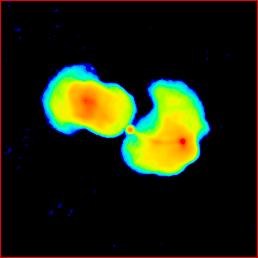 Image:
Image:3C 388 | B1842+455 |
| S178 | Alpha | FR | Class | ID | Spectrum | Best z | mag. | LAS | lg P178 | D |
|---|---|---|---|---|---|---|---|---|---|---|
| 26.8 | 0.70 | II | R+HB | Gal | 0.0908 | R = 14.12 | 51.40 | 25.53 | 77.7 |

| Size: | 76.8 × 76.8 arcsec² |
|---|---|
| LUT: | Logarithmic |
| Beam: | 1.32 arcsec |
| Frequency: | 1385 MHz |
| Method: | CLEAN Õˆÿ>1.32
|
| Telescope: | VLA B+C |
| Credits: | Roettiger et al. (1994) |
The radio structure of 3C388 initially appeared to be a typical classical double (e.g. Burns, Owen & Rudnick 1978). On closer examination this description has become increasingly innappropriate. On our system the eastern lobe is classified as relaxed: there is a moderately compact "warmspot" near the centre of the lobe but its surface brightness is too low to qualify as a true hotspot. Unlike typical classical doubles, the eastern lobe is not edge-brightened. Instead, there is a diffuse "relic" lobe outside the main lobe (the latter appears orange in our image). The boundary between these two is marked by a sharp drop in brightness and increase in spectral index (Roettiger et al.); as our image shows, the outer edge of the relic lobe itself is also very sharp.
The western lobe contains a curved, well-collimated jet linking the core with the bright hotspot. A tail or flare of emission extends south from the hotspot, and Roettiger et al's spectral index map shows that this region has a relatively flat spectrum; presumably this is the current outflow from the hotspot. In contrast the wing of emission to the north seems to be analogous to the eastern relic, with a steep spectrum and a much lower brightness than the main lobe emission surrounding the jet. Roettiger et al.'s high resolution 4.8 GHz image also shows a probably counter-jet (their "finger") in the eastern lobe.
Roettiger et al. note that there is little depolarization asymmetry
between the two lobes. Since the X-ray core radius is comparable to
the radio size, a significant asymmetry would be expected unless
the source axis is rather close to the plane of the sky.
This would be consistent with the clear gap between
the lobes and with the detectability of the counterjet.
| Prev. | Data Page | Other images | Next | Search | Alphanumeric List | Icon List | Atlas Index |
|---|